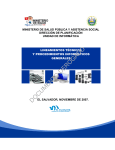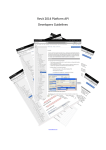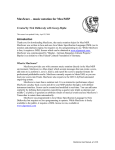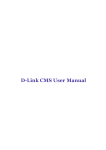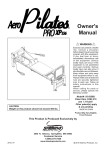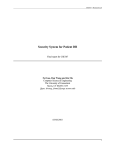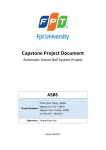Download NMA Application Report
Transcript
Newark Medical Associates
Application Report
Luis Serpas
Table of Content
1. Introduction to Report
2. Intended Users
3. Necessary Configurations (To create an Instance)
4. Components and their Assets (List)
5. Technical Report
6. Building the Instance & User Manual
-Screenshots
1. Introduction
This report is composed of two sections. The first section is called the Technical
Report which describes the individual components of the Newark Medical Associates
Database and Web Front End. They components are a series of php and html files
organized into a folder hierarchy to prompt ease of modification and navigation.
The second section will guide a typical end user through the menu options and
navigation of the applications front end.
2. Clients
The clients of this manual include the developers who will have access to the
code with the intent to alter the front end, end users who will the NMA application
only through the forms and buttons provided and to any user who wishes to create
an instance of the exact application using the assets provided.
3. Necessary Configuration
Local apache server should be set up to run the application. MAMP could be used
for MAC OS or XAMPP in Windows. The MySQL server should also be set up in order
to run the database MySQL but this included with the XAMPP software.
The apache server is a directory located in the htdocs directory within the users
program files in their c drive under XAMPP. The user simply needs to copy the entire
folder NMA folder and place it into htdocs. Access to the website by using a browser
to reach http://localhost/nma/home.php.
4. Components and their Assets
**All assets are of type php unless stated otherwise.
Component
Assets
Database Input
(Located in PHP folder)
account
addNurseSkill
deleteEmployee
addAdmit
addOwner
deleteNurse
addAllergy
addPatient
deletePhysician
addClinic
addPatientAllergy
deleteSchedule
addClinicBed
addPhysician
deleteStaff
addClinicEmp
addPrescription
deleteSurgeon
addConsult
addShift
getSafeData
addCorporation
addShiftSchedule
scheduleSurgery
addDiagnosis
addSurgeon
updateNurse
addEmployee
addSurgery
updatePhysician
addIllness
addSurgeryReq
connect.
addMedical
addSurgerySkill
getSafeData.php
addMedication
addSurgeryType
Login.php
addMedReact
deleteAdmision
addNurse
Front End Display
(Located in root NMA
and Form
folder)
addMisc
addPatient
addScheduleShift
addShiftSchedule
addStaff
footbar.html
home
inPatientManage
miscManage
navBar.html
schedule
staffManage
updateNurse
updatePhysician
Javascript Menu
PopUp
Front End Theme
and Style
(Located In assets folder)
nmaButton.js
(Located In js folder)
nmaStyle.css
viewAllergy
viewPatientAllergy
viewClinic
viewPhysician
viewClinicBed
viewPrescription
viewClinicEmp
viewReactWith
viewConsult
viewSchedule
viewCorporation
viewScheduledSurge
viewDiagnosis
viewEmployee
viewIllness
viewMedical
viewMedication
viewNurse
viewNurseSkill
viewAdmitted
ry
viewSurgeon
viewSurgery
viewSurgeryReq
viewSurgerySkill
viewSurgeryType
viewOnwer
viewPatient
5. Technical Report
Section 4 listed all the assets that make up the Newark Medical Associates
Application. Further it breaks it into components that share some similarities in
functionality. This similarity is also translated to the code which would be nearly
identical copies were it not for their access to different tables and different sql
statements.
In this section I attempt to provide a better understanding of the assets that
make up the individual components of the NMA application. Beginning with the
Database input.
Database Input
The assets under this component reside in the PHP folder of the NMA
application and their purpose is to be called through a post action that occurs in the
forms located in the applications front end. These assets include addPrescription,
addMedicine, addPatient.
The typical code within each of this files is similar to the following:
**This is sample code found in the addEmployee php file
All the php files and indeed any section of code that makes use of php includes
the first three lines that import the account, connect, and getSafeData files that are
stored in the php folder. Their purpose of the account file, for instance, is to specify
the account and password used to login to the mySql backend.
<?php $hostname = "localhost";
$username = "root";
$password= "toor";
$project = "nma";?>
The connect file then uses the account in order to login to the backend.
//account connection
$dbh = mysql_connect($hostname, $username, $password) or die ("Error");
//database selection
mysql_select_db($project);
The getSafeData file which is used throughout all the input files makes sure that any
input is sanitized to avoid sql injection.
include ("account.php");
include ("connect.php");
include ("getSafeData.php");
$id = getSafeData($_POST["empid"]);
$name = getSafeData($_POST["name"]);
…
//all these variables will get the information that is submitted into the forms
$s = "insert into employee(empid, name, salary, gender, address, type, ssn, phone)
values ('$id', '$name', '$salary', '$gender', '$address', '$type', '$ssn', '$phone')" ;
if(!empty($id) && (((int)$salary)>25000) &&(((int)$salary)<300000))
{
mysql_query ( $s ) or print (mysql_error());
…}
Please note that the if statement found here shows an example of a business
rule that I chose to implement here in the php file rather than the database.
Although I had attempted to use triggers or an enumerated column this method
proved to be simple and easily mimicked throughout the other php files where other
business rules were implanted another case such as this is the Risk of Heart
condition business rule…
$riskOf = ($hdl+$ldl+((1/5)*$tri))/$hdl;
$risk = '';
if($riskOf<4){risk ='N';}
if((4<$riskOf)&&($riskOf<5)) {$risk ='L';}
if(5<$riskOf) {$risk ='M';}
Front End Display and Forms
The php files located in the root of the NMA folder are tasked with providing
for the user the mechanism by which they can input data into the backend database
and also retrieve, view, delete, and update certain table’s date such as a patient’s
assigned nurse.
Typically files located here are following the naming convention of view[Table],
for instance, viewNurse, viewEmployee, viewAllergy, viewIllness to name a few.
These files are all of the type php except for a few such as the navbar.html or
footbar.html though renaming them wouldn’t change their functionality which is to
provide the links for the user access the different front end sections.
The front end sections are the following and they are listed in the applications
Navigation Bar they accessible from anywhere on the site.
Section
Form
Add Patient
(addPatient)
View Patient
Add Staff
View Staff
Available
Add Patient
Add Diagnosis
Add Consult
Add Prescription
Add Surgery
Add Medical
Add Allergy
(patientManage)
Patients
Diagnosis
Consultations
Prescription
Surgeries
Medical Data
Patient Allergy
(addStaff)
Add Employee
Add Physician
Add Nurse
Add Surgeon
Add Nurse Skill
Add Owner
Add Clinic Emp
(staffManage)
Employees
Physicians
Nurses
Surgeons
Nurse Skills
Owners
Clinic Emp
In Patient
Add Misc.
View Misc.
Schedule
(inPatientManage)
Add Bed
Admit To
Update Physician
Clinic Beds
Admitted
Update Nurse
Add Allergy
Add Surgery Skill
Add Medication
Add illness
Add Corporation
Add Med Reaction
Add Surgery Type
Add Clinic
Add Surgery Require
Allergy
Surgery Skills
Medications
Illness
Corporations
Med Reactions
Surgery Types
Clinics
Surgery Req Skills.
Add Shift
View Schedule
Schedule
Schedule Shift
Schedule Surgery
(addMisc)
(miscManage)
(schedule)
This table breaks up the applications front end home page into the different links that
allow the user to provide input for new employees, new nurses, new patients; it also
provides for the user the ability to view table data such as view Nurse, and view Patients.
The front end divides the different functionality input / output into separate pages so
that the user can input data for any given entity from the same menu option or vice a
versa view any information about a given entity. This design feature is to simplify the
page layout into obvious and specific functions that directly tie into the folder and asset
hierarchy. This allows a developer to easily navigate to and update a piece of code from
any asset that makes up the application easily and in exactly the same way for the
different entities.
Type 1:
There are three basic front end php files. The first and the simplest type only provide the
user with a list of form options through which they can input data. For example the php
file for addPatient.php contains the following code.
<div id="selection" class="height">
<h2>Select Form</h2>
<table id="table" border ="1">
<tr><th>
<input class="button" type="button" value="Add Allergy"
onclick="Display('allergyForm')" /></th></tr></table></div>
A typical front end php file contains two parts; the first part is the div which shows the
users the different forms that they can pick to view.
Upon loading the page all forms are rendered hidden. The way to make the forms visible
is through the javascript file nmaButton. This javascript file is in charge of displaying the
form the user wants to view based on which button he pressed.
The file is also charge of hiding any forms that had been previously viewed.
Html is not a dynamic language and typically the content is static, the javascript
overcomes this and gives the page a bit more fluidity.
The second portion of a typical front end php file is the form that is displayed to the user
and through which the user is able to post data the php files that are charge of directly
accessing the backend using sql.
This form displays the data that makes up a typical allergy entity including the allergy
code and description.
The addpatientAllergy php file is used to take data input through this form and inserts it
into the database. This file is called upon the user pressing the submit button.
<form action="php/addPatientAllergy.php" method="post" id="allergyForm"
style="display:none">
<h2>New Patient Allergy</h2>
<table
border ="1">
<tr><th>Patient ID</th>td>input type="text" name="id" maxlength="5" /></td></tr>
<tr><th>Allergy Code</th>td><input type="text" name="allergy" maxlength="5"
/></td>tr>
<tr><th colspan="2"><input class="button" type="submit" value="Submit"/>
</th></tr></table></form>
Type 2 and 3:
The next type of php file that makes up the front end of my NMA application simply
provides for the user a table populated with data from the backend, the table is further
styled using the nmaStyle.css file located in the assets folder.
This is the typical code for displaying a table using php, sql, and css.
<?php
$selectAll=("select *from nurse, employee where nurse.nurseIdCode =
employee.empId;");
$result = mysql_query($selectAll) or die();
echo "<table id='phpTable'>";
echo "<tr><th>Actions</th>
<th style='width: 150px;'>ID</th>
<th style='width: 150px;'>Name</th>
<th style='width: 150px;'>Surgery Type</th>
<th style='width: 150px;'>Grade</th>
<th style='width: 150px;'>Years</th></tr>";
while($row = mysql_fetch_array($result))
{$code=$row['nurseIdCode'];
$name=$row['name'];
$surgery=$row['surgeryTypeCode'];
$grade=$row['grade'];
$years=$row['years'];
echo "<tr><td>
<a href='home.php'>home</a>
/<a href='php/deleteNurse.php?code=".$code."'>Delete</a></td></td>
<td>
<input class='noUpdate' readonly='readonly' type='text' name='code' value='".$code."'
/></td>
<td>
<input class='noUpdate' readonly='readonly' type='text' name='name'
value='".$name."' /></td>
<td>
<input class='noUpdate' readonly='readonly' type='text' name='surgery'
value='".$surgery."' />
</td>
<td>
<input class='noUpdate' readonly='readonly' type='text' name='grade'
value='".$grade."' />
</td>
<td>
<input class='noUpdate' readonly='readonly' type='text' name='years'
value='".$years."' />
</td>
</tr>";
} // End our while loop
echo "</table>"; ?>
This piece of code displays the last two types of php files that are used to display data for
the user and also allow the user to update the data directly.
In this case this table is displayed within another html file thereby inheriting all the
stylistic effects already present in the original html file. This table merely need identify
itself with an existing class element found in the nmaStyle.css file in order to be stylized
according to the applications theme.
Furthermore the table allows a user to directly alter the data located in the table by
placing the created table within a form whose submit button is placed in the column of
the table.
This form, unlike the others previously used, sends data to the php files using a get
method. The reason is this allowed me to directly name the variable I would be sending
to the php file. In this case I send the variable code which is the Nurses User Id.
The id is sent to a php filed called deleteNurse and this uses the code to delete the entity
that whose id matches it.
Another similar cases updates the information rather than the deletes it. The two sql
statements are listed next:
In order to delete:
$code = $_GET['code'];
mysql_query("delete from nurse where nurseIdCode='$code'") or die(mysql_error());
Using an sql set in order to alter data.
$pnum = getSafeData($_POST["id"]);
$nurse = getSafeData($_POST["nurse"]);
$s = "update patient set attendingNurseId='$nurse' where pnum = '$pnum'";
mysql_query ( $s ) or print (mysql_error());
Javascript Menu PopUp
This script simply works like a switch and turns table visibility off, if already on, or on if
already off. The form displayed or hidden depends on which form the user wants to see.
The id of which is sent to the script via a variable ‘id’ to the js function Display(id).
//hidding previous form
document.getElementById(lastId).style.display="none";
//revealing selected form
document.getElementById(id).style.display="block";
Front End Theme and Style
This file called the nmaStyle.css is charge of the dimensions of the website, how
elements overflow, the color scheme, basically all color and physical appearances of the
website are dictated here.
With a blank cascading style sheet the website would simply be white with black text
with pages that would extend vertically infinitely since all the elements would be placed
one after the other instead of overlayed the way in which they are style now.
In this respect I coded the website with a green theme since that is typically a clean,
natural, and calming color.
6. Creating an Application Instance and user Manual
The section describe how to create an instance of the application and is followed by
a simple user manual.
1.) First the mysql database used should have a username and password set to ‘root’
and ‘toor’ respectively. This isn’t necessary if you wish you can also alter the
information already in the account.php to match that of an existing mysql account
2.) Create a folder within the htdocs, (after having installed xampp), name it nma and
place the contents of this folder into it. You can also simply drag the entire nma
folder into htdocs.
3.) Create the tables and populate them using the sql statements and inserts
provided in the sqlRelations&Data.doc file.
Step 1:
Start Apache and MySql
Visit localhost/phpmyadmin
Click Home, Databases, then Create a new DB (in this case NMA)
Step 2:
Click newly created Database
Press SQL
Then copy and paste the sql provided to create the tables, (there is sample inputs
included)
Step 3:
After transferring content into NMA in htdocs
Visit localhost/NMA /home.php to access the home page.
Step 4:
This is screen shot of the main user interface provided by the application.
On the left there is a list of buttons that upon clicked will reveal the related form. The
user can then insert the necessary data and submit it the php files which will in turn
insert it into the sql database.
Step 5:
The following is the next basic functionality provided by the website. All information
from a table is provided for the user by populating a table located within the html
page. To access any one of this table a user simply clicks a button akin to those
shown in the previous image. Upon doing so the user will be sent to a page similar to
the own displayed below.
Certain tables provide the user with the ability to update the data in the table. Such
functionality is evident through the provided submit button that isn’t absent in most
read only tables.






















